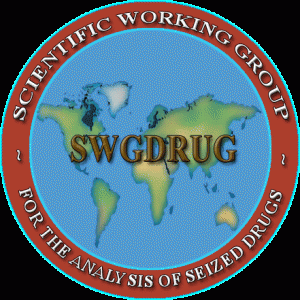This is a multipart series that will examine the prosecution of controlled substance “analogs” by both the state and federal governments.
- Part one: The controlling law
- Part two: What is an analog? The scientific problem
- Part three: Efforts to define analog
- Part four: Ohio v. Silmi et al.
There are two main efforts that are currently ongoing.

The Scientific Working Group for the Analysis of Seized Drugs (SWGDRUG) has posted the DRAFT document “SWGDRUG Recommendations on Analogues and Structural Class Determinations.” It is a very short document. It really does little to solve the scientific issue in the courtroom. It reads as follows:
SWGDRUG Recommendations on Analogues and Structural Class Determinations
- Introduction1.1 This section provides general recommendations regarding analogues and structural class determinations.
1.2 Jurisdictional requirements for such determinations may include structural or pharmacological (real or purported) similarity to known controlled substances or structural class definitions.
1.3 SWGDRUG considers it fundamental for analysts to fully understand how analogues and structural classes are legally defined in a particular jurisdiction prior to developing or reporting opinions.
1.4 Such opinions should only be rendered by those with proper training and experience.
- Analogues2.1 The requirements for legal consideration as a controlled substance analogue are defined in jurisdictional legislation.
2.2 Classification as a controlled substance analogue generally involves the evaluation of the similarity of structure or pharmacological properties of a chemical compound to a known controlled substance.
2.3 The scientific evaluation of similarity may be made using a variety of techniques and approaches depending on the specific question being addressed. These specific comparisons can be broadly classified by structure, chemical properties, biochemical or pharmacological activity.
2.4 Evaluation of similarity shall include comparisons of an appropriate nature sufficient to meet jurisdictional requirements.
2.5 The evaluation of similarities between chemical compounds should be documented. This should include a discussion of how the compounds are similar and how they are different.
2.5.1 Evaluation of similarity is a subjective matter and opinions may differ.
2.5.2 Structural comparisons in a forensic laboratory are likely to be limited to the structural class and functional group, ring or chain substitutions. As examples, isomers, homologues, salt forms, esters and ethers may be considered. The scope of comparison conducted should be made clear in the report.
2.6 Structural similarity between two chemical compounds is not an adequate basis to infer similar pharmacological activity.
2.7 Likewise a lack of structural similarity is not an adequate basis to infer a lack of analogous pharmacological activity.
2.8 If pharmacological activity is a requirement of particular legislation, the drug analyst should limit his inference and considerations to the citation of peer-reviewed literature, or relevant sworn statements in legal proceedings in absence of specific training and experience in pharmacology (or related fields).
- Structural Class Determinations3.1 In many jurisdictions, chemical compounds are controlled based upon structural class definitions (e.g., 3-(1-naphthoyl) indole with substitution at the nitrogen atom of the indole ring, whether or not further substituted on the indole ring to any extent, whether or not substituted on the naphthoyl ring to any extent).
3.2 A structural class determination may be made by identifying a specific compound and assigning the compound as a member of a legal structural class.
3.3 A structural class determination may also be made using an analytical scheme designed to identify sufficient features of a compound to assign it as a member of a legal structural class without making a conclusive identification of that compound (e.g., ortho, meta, or para position of a halogen on an aromatic ring).
3.4 Any relevant limitations of the analytical scheme and resulting classification shall be clear in reporting.
- Reporting4.1 All conclusions and opinions expressed in written or oral form shall be based on sufficient supporting evidence, data, or information.
4.2 The basis of any conclusion should be completely documented in the case notes and summarized in the written report and subject to the laboratory’s review policy.
4.3 Conclusions and opinions reported shall be accurate, clear, objective, and meet the jurisdictional requirements. The report must also include any assumptions or limitations (e.g. potentially exculpatory information), to allow the court to make the final decision.
4.4 The report should clearly indicate what elements of the legal requirements were evaluated and what elements were not evaluated.
4.5 The scope of opinions and conclusions reported shall not go beyond the knowledge, training and experience of the analyst.
A much more promising and robust effort that is by its mission statement a-political is the efforts of the members of the Advisory Committee for the Evaluation of Controlled Substance Analogs (ACECSA). According to their website, “[t]he mission of the Advisory Committee for the Evaluation of Controlled Substance Analogs (ACECSA) is to recommend minimum standards for the evaluation of non-controlled substances being considered as analogs of controlled substances.” They have different subcommittees that are based upon a logical exploration of what should be examined when we try to better understand what is or is not an analog and what is or is not “substantially similar.” The subcommittees include:
- Structure (chemical backbone, functional groups, core structure, 3-D structure)
- Physicochemical Properties (chemical reactivity, ex vivo, in vivo, computation/empirical data, physical properties)
- Computation Chemistry and Cheminformatics (Molecule similarity algorithms, QSAR)
- Literature Support (published, unpublished, dissertations, research, meeting abstracts)
- Synthetic Pathway
- Pharmacology/Toxicology


